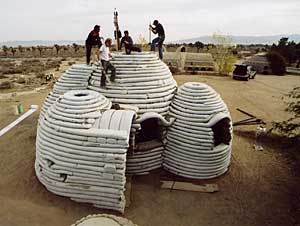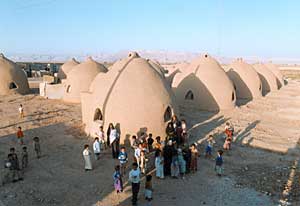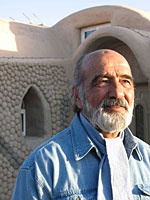|
|
Nader Khalili, an Earth Architect and teacher known for his innovative work with adobe, died on March 5 of congestive heart failure. He was 72 years old. Among his best-known inventions is the “super adobe” Earthbag construction system. He developed it during the early 1980s in response to a call for designs for human settlements on the Moon and Mars by the National Aeronautics and Space Administration. The system consists of oblong plastic bags that are filled with dirt and then laid in circular courses, like the blocks of an igloo, and held in place by barbed wire. When covered in stucco, the bags create form a permanent shelter.
Khalili championed Earthbag houses—which cost as little as $500—as an affordable solution for poverty stricken areas in Africa, India, and South America. He received special recognition from the United Nations for his “Housing for the Homeless” proposal in 1987 and his prototypes were recognized with the Aga Khan Award for Architecture in 2004. Khalili also invented the Geltaftan Earth-and-Fire system. Most adobe houses are unable to withstand earthquakes and strong winds, so Kahlili imagined a fired-adobe structure—dubbed the “ceramic house”—that could resist these elements.


Photos courtesy Cal-Earth Institute
Nader Khalili (top) designed the Earthbag shelter (middle), which was recognized with the Aga Khan Award for Architecture in 2004. When these sandbags are covered with wire mesh and stucco, they become low-cost permanent housing (above).
Born in Tehran as one of nine children, Khalili studied Persian literature and poetry at the University of Teheran. He moved to Istanbul in the 1950s, where he studied engineering and architecture at the Istanbul Technical University. Khalili came to the United States in the early 1960s, settling in Los Angeles, but became disenchanted with designing high-rise apartments and parking structures there—so he returned to Iran, in the mid-1970s, to study rural village homes that were closer to nature. His involvement with Earth Architecture and third world development lead him, in 1991, to found the Cal-Earth Institute, near Hesperia, California, which teaches students learn how to construct his low-cost dome-shaped houses.
A professor at the Southern California Institute of Architecture, Khalili was also the author of five books, including Ceramic Houses and Earth Architecture: How to Build Your Own. During the mid-1990s, the Hesperia Department of Recreation and Parks created the Hesperia Museum and Nature Center to showcase his designs. His work has also been shown at the Pompidou Center, in Paris. Khalili is survived by wife, Iliona; son, Dastan; daughter, Sheefteh; eight brothers and sisters; and extended family.



